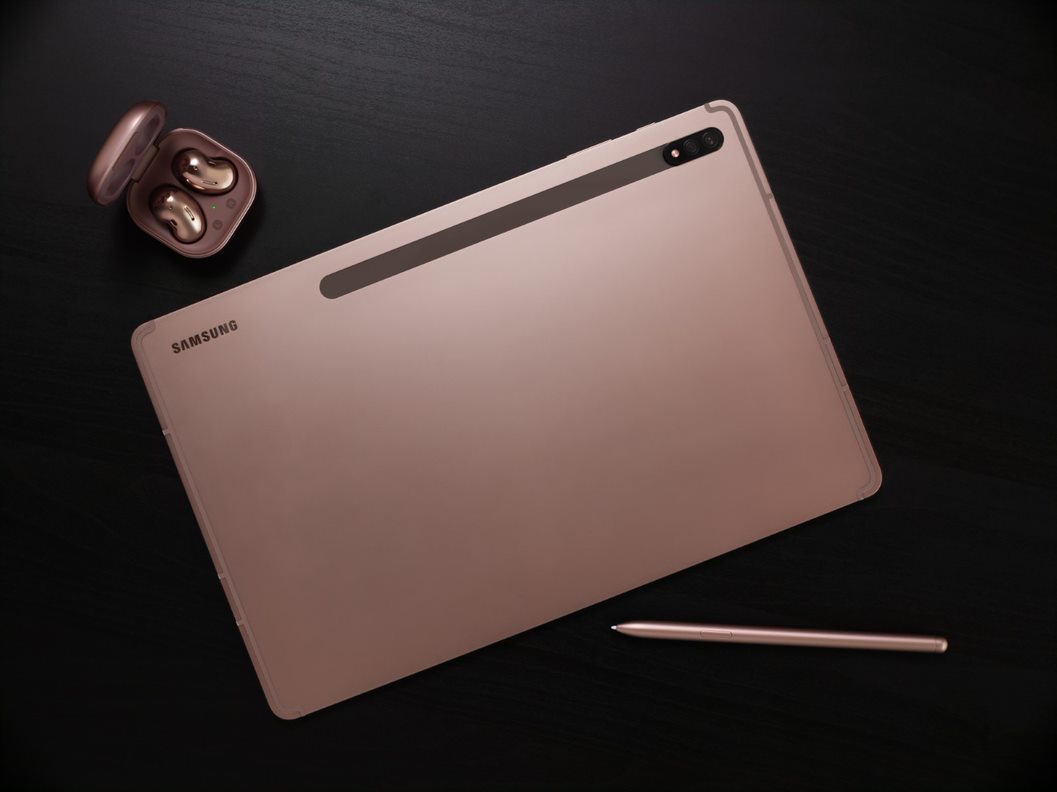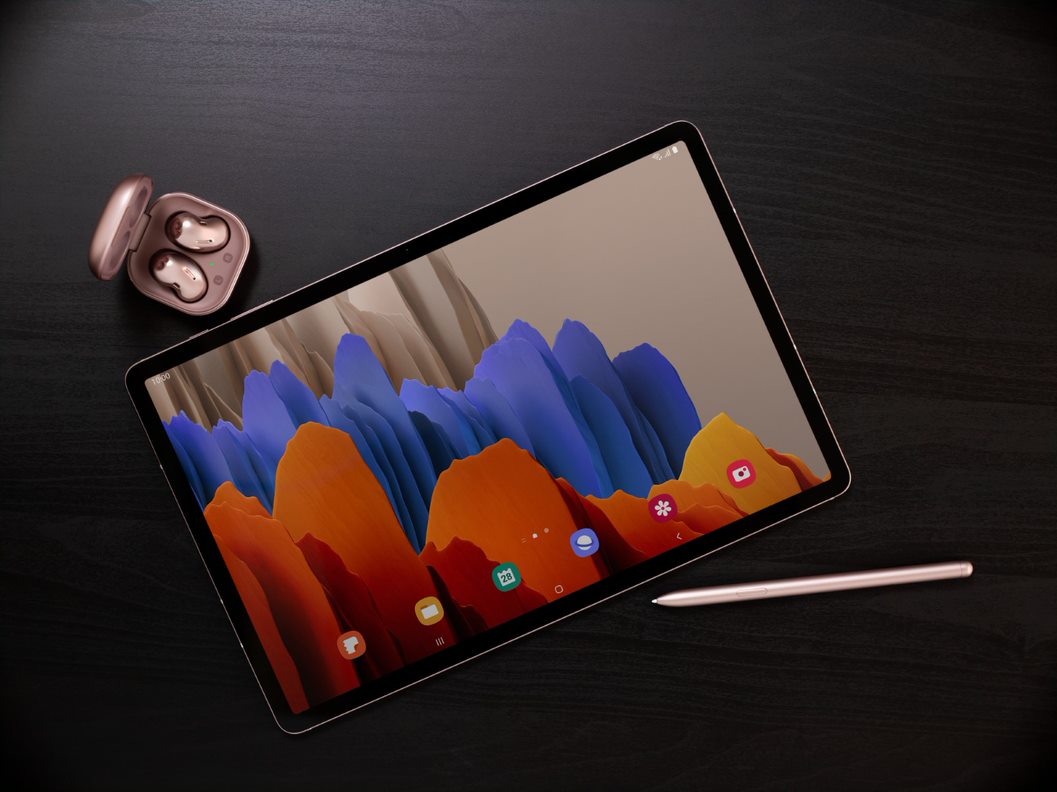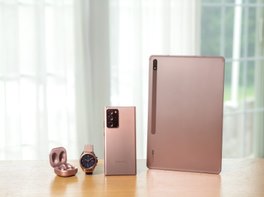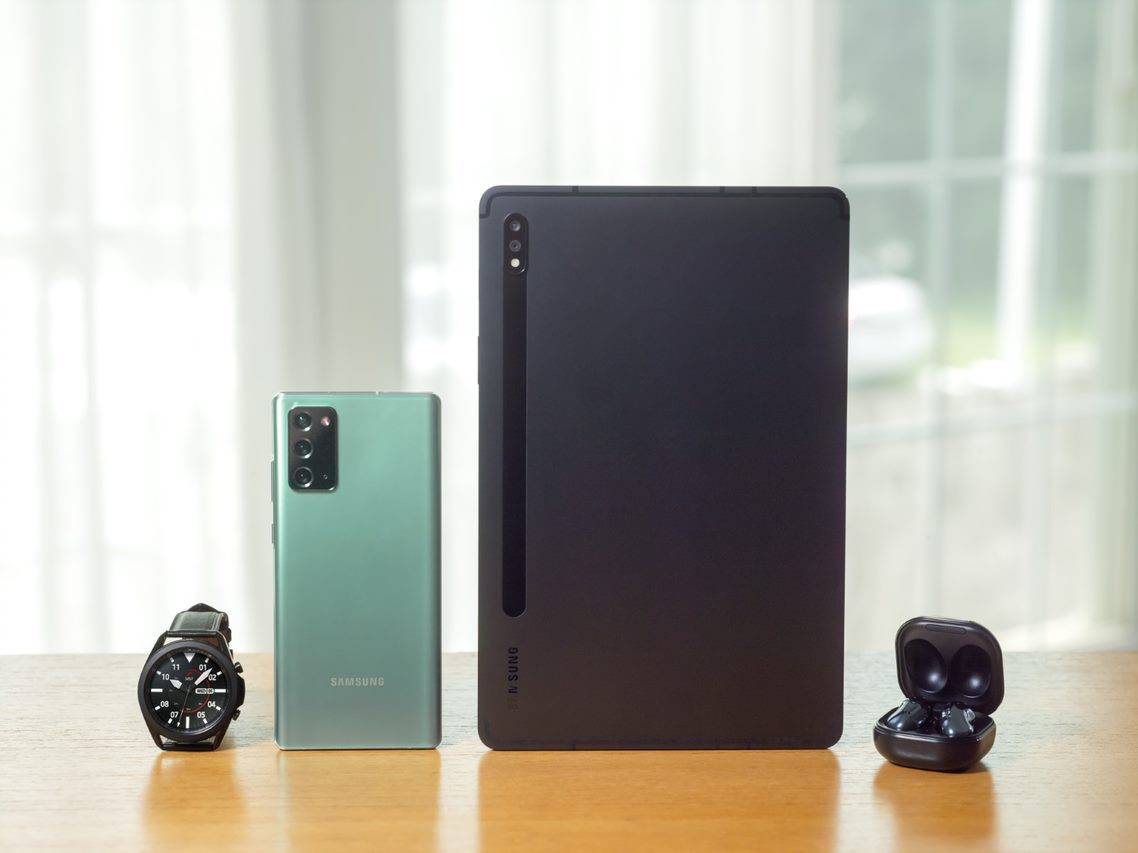Samsung Galaxy Tab S7, Galaxy Tab S7+ unveiled — the iPad Pro has competition
The Galaxy Tab S7 and Tab S7+ add 5G, among other new features

Samsung unveiled today the Galaxy Tab S7 and Galaxy Tab S7+, the latest versions of its flagship Android tablets. Revealed during the digital Galaxy Unpacked event, the two slates come with updated internals, 5G connectivity and a brand new S Pen included in the box. Samsung also revamped the external keyboard (sold separately) and outfitted both tablets with a 120Hz display. Speaking of which, the Galaxy Tab S7 and Tab S7+ have larger 11-inch and 12.4-inch screens, putting them squarely in the premium tablet terrority dominated by the iPad Pro.
This is the first time Samsung has released two versions of a tablet. The Tab S7 is a cheaper model with an 11-inch display while the Tab S7+ pushes its premium status with a 12.4-inch AMOLED panel. The two options are similar in most other areas, so the most important consideration when choosing between them is whether you need a larger display.
We'll go over the differences between the Galaxy Tab S7 and Tab S7+ below and give you a full breakdown of the new products, so you can choose the best tablet for your needs.
Samsung Galaxy Tab S7 and Tab S7+ price and release date
The Samsung Galaxy Tab S7 will start at $649 and come equipped with a Qualcomm Snapdragon 865+ chip, 6GB of RAM and a 128GB SSD. For $849, you can upgrade to the Galaxy Tab S7+ with the same specs.
Both tablets will be available with 8GB of RAM and a 256GB SSD, but Samsung has not provided pricing on that config yet.
Samsung says the Galaxy Tab S7 and Galaxy Tab S7+ will be available in the fall. We will update this article when we get more specifics.
Galaxy Tab S7 and Tab S7+ design
Based on the press images Samsung sent us, the Galaxy Tab S7 and S7+ appear to have the same design DNA as their predecessor, the Galaxy Tab S6. From the front, the Galaxy Tab S7 and Tab S7+ look like most tablets except they have thin display bezels, similar to the iPad Pro. This allows you to focus entirely on the large 11-inch and 12.4-inch panels without being distracted by thick black bars.
Sign up to receive The Snapshot, a free special dispatch from Laptop Mag, in your inbox.
The only change Samsung appears to have made to the front of the Galaxy Tab S7 is moving the selfie cam to the longer edge of the tablet so you can use the camera in landscape mode when it's connected to the keyboard.

Flip the Galaxy Tab S7 around, and you'll immediately notice the new color options: Mystic Bronze, Mystic Silver and Mystic Black. We'll have to see how they look in person but I'm a bit bummed that Samsung shifted from vibrant colors to clichéd shades.
Also on the back is an off-tone teardrop-shaped magnetic stylus holder that extends from beneath a dual-camera module. This replaces the magnetic groove Samsung used on the Galaxy Tab S6 to house the stylus when it's not in use.

In the photos, you can also see some extensive antenna bands on the back of the tablet and the edges appear to have a brushed finish. There is a single USB 3.2 Type-A charging port located on the bottom of the Galaxy Tab S7, and an in-display fingerprint sensor for fast and secure login.
At 10 x 6.5 x 0.25 inches and 1.1 pounds, the Galaxy Tab S7 is lighter but a tad thicker than the Galaxy Tab S7+ (11.2 x 7.3 x 0.22 inches and 1.3 pounds).
Galaxy Tab S7 and Tab S7+ display
Samsung always delivers when it comes to picture quality, whether it's on a smartphone, tablet or TV. The Galaxy Tab S7 and Tab S7+ will likely extend the company's excellent track record.
Before I get into the details, it's worth pointing out that the display size and type are the biggest differences between the Galaxy Tab S7 and Tab S7+, so read this section closely if you're torn on which one to buy.

The Galaxy Tab S7 has an 11-inch, 2560 x 1600 (WQXGA) LTPS TFT display with a refresh rate of up to 120Hz. Upgrading to the Galaxy Tab S7+ gets you a 12.4-inch Super AMOLED panel with a 2800 x 1752-pixel resolution and a 120Hz refresh rate.
We haven't seen these in person but we're confident they'll look great considering Samsung always puts some of the best displays on its flagship products.
Samsung Galaxy Tab S7 and Tab S7+ S Pen, Book Cover and DeX
Samsung revamped the S Pen by making it more responsive and accurate so artists get instant feedback as they drag the stylus across the Tab S7's touchscreen panel.
A favorite feature for Galaxy Note loyalists, the new S Pen reduces latency by 40% and drops the response time from 42 milliseconds to 9ms. The updated stylus is also a bit thicker, which should make it more comfortable to hold for longer drawing or writing sessions.

When you want to use the Galaxy Tab S7 as a laptop, you can connect it to the optional keyboard attachment. Also updated this year, the new Book Cover keyboard now has a larger touchpad that supports multi-touch gestures, a delete key, function keys and full-sized Enter and Shift keys.
On the subject of being a laptop replacement, DeX returns to the Galaxy Tab S7 and Tab S7+ after a hiatus on the Tab S6 Lite. For the uninitiated, DeX is Samsung's custom desktop interface that makes the Tab S7 feel more like a laptop and gives you more extensive multitasking options.
Galaxy Tab S7 and Tab S7+ performance
Powering the Galaxy Tab S7 and Tab S7+ is a Qualcomm Snapdragon 865+ chip, the same one found in the Galaxy Note20 and Note20 Ultra. Along with 5G support, the chip should bring a nice performance boost over the Snapdragon 855 found in the Galaxy Tab S6.
Both models come with the same internals, including 6GB of RAM and a 128GB SSD to start. Customers can upgrade to a more powerful config with 8GB of RAM and a 256GB SSD.
Samsung Galaxy Tab S7 and Tab S7+ 5G
There was some speculation that the Tab S7+ would be a 5G version of the Tab S7 and that the cheaper model would be limited to Wi-Fi only or 4G LTE. That turned out to be false. Instead, Samsung is sharing 5G with all of its new flagship products.
Both the Galaxy Tab S7 and Galaxy Tab S7+ support a 5G connection, so you should get the fastest cellular speeds around if you're in a 5G-covered area. As of now, 5G is pretty limited and only a few wireless carriers have a live network. We tested Verizon's 5G network with the Lenovo Flex 5G and got speeds of up to 1.2 gigabits.
Samsung Galaxy Tab S7 and Tab S7+ audio, cameras and battery life
The Tab S7 and Tab S7+ have a quad-speaker setup that, if it's anything like the Galaxy Tab S6, should pump out rich, loud audio. The sound is crafted by AKG (now owned by Samsung) so we're expecting balanced audio.

As for the cameras, the Galaxy Tab S7 and Galaxy Tab S7+ have a 13MP main camera and a 5MP secondary ultra-wide lens. On the front is an 8MP selfie camera.
Last but not least, the Galaxy Tab S7 has an 8,000mAh battery while the larger Galaxy Tab S7+ has a 10,090 mAH cell. We'll need to put these slates through our own battery test before we can give any definitive runtimes. For comparison, the Galaxy Tab S6 lasted for just short of 9 hours on a charge.
Samsung Galaxy Tab S7 and Tab S7+ outlook
Based on specs and features alone, the Galaxy Tab S7 and Tab S7+ appear to be solid upgrades over the Galaxy Tab S6. They come with 5G connectivity, a faster processor, and an upgraded S Pen is included in the box while an improved keyboard can be purchased separately.
Most importantly, both tablets have a larger display than the S6 with the Galaxy Tab S7+ expending the screen to 12.4 inches. This puts Samsung's flagship Android tablet in iPad Pro territory. Is the Galaxy Tab S7 worth the upgrade? Can it compete with the iPad Pro? We'll get you these answers later this year once we've published our full review.
Phillip Tracy is the assistant managing editor at Laptop Mag where he reviews laptops, phones and other gadgets while covering the latest industry news. After graduating with a journalism degree from the University of Texas at Austin, Phillip became a tech reporter at the Daily Dot. There, he wrote reviews for a range of gadgets and covered everything from social media trends to cybersecurity. Prior to that, he wrote for RCR Wireless News covering 5G and IoT. When he's not tinkering with devices, you can find Phillip playing video games, reading, traveling or watching soccer.

